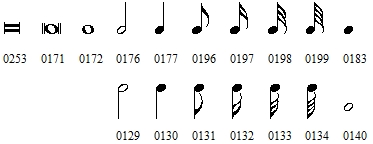
Bach (release 4.1) contains many music symbols but also retains much of the original alpha-numeric characters found in a Roman-family font.
Preserved symbols are:
! & + / | ? ( ) [ ] { } : ; . , ' " 0 1 2 3 4 5 6 7 8 9 A B C D E F G H I J K L M N O P Q R S T U V W Y Z a b c d e f g h i j k l m n o p q r s t u v w x y z
Musical symbols are located outside the normal alpha-numeric character areas, i.e. outside ASCII range. Some symbols have the kerning width narrower than their character width, so that two or more symbols can be combined to create a distinct symbol.
Bach uses this concept to increase infinite variety of musical symbols in the following areas:
In the following section, all the musical symbols are classified and described, together with their keyboard equivalent; if not available, the 4 digit ANSI number is provided. (The symbol can be typed in by hitting numbers on the numeric keypad while holding ALT key. Ensure that the Num Lock is on.

All accidentals of normal size are keyboard accessible. (Double-flat should be created with two flats.) The reduced-size symbols are provided for special purposes (e.g. indicating implied raised / lowered pitch).

| Until Bach release 2.3b the font contained notes up to hemidemisemiquavers (64th) in up-stemmed symbols, but from Release 3.0, down-stemmed symbols are added for non-beamed symbols. The kerning width of all the up-stemmed notes is set uniformly to the point where a dot can be placed (see Fig. 1 on the right). Thus all the flagged symbols have the same kerning width narrower than the width of the symbol. |  Fig.1
|

Beamed notes are designed to be joined with other beamed notes. Most frequently used ones, - and =, are accessible from keyboard. The original symbols (hyphens and equal sign) are reallocated to “ \ ” and ANSI 0173 respectively.
All the beamed notes have the same kerning width. This design allows a dot to be placed beside its note-head in contiguous beamed symbols without requiring a separate symbol for the beam. When a dot is not required, either a space or ANSI 0160 (non-breakable space) should be typed in its place. (The non-breakable space is normally accessible by hitting CTRL space or SHIFT space; consult User Manual of each application program.)
There are beam-only-symbols for quaver and semiquaver: with kerning width (ANSI 0141 and 143 respectively) and without kerning width (ANSI 0142 and 0144 respectively. They will allow further variation of symbols (e.g. double dot notation).

The symbols whose values are smaller than 1/8 have kerning widths narrower than the character width, for the same reason as for the notes.

There are three clefs, but variations of each can be further specified such as ANSI 0170 L1 for a soprano clef, for example.
There are three different bar line symbols ‘normal’, ‘dotted’ and ‘thick’. By mixing them with : (colon), you can create a repetition mark such as :||:. Bar lines. ANSI 0242 and 0243 are unique symbols used in MSS study indicating the change of system / page respectively.

The numeric time-signatures are made up by a set of two numbers and must be typed in correct sequence - the upper number followed by the lower. Upper numbers do not have kerning widths, so that the following numbers can be overlaid to form correct symbols.
Bach includes three kinds of fermatas: the last one (wedge shaped) is perhaps useful only in the discussion of J. S. Bach’s music.

| Most ornaments consist of several components: for example, a standard trill is composed of two "~"s followed by ANSI 0252. By combining various shapes, you can create infinite variations. Kerning width is again creatively exploited here, as shown in Fig.2. |  Fig.2
|

Arrow symbols can be used for specifying direction of any kind, such as revisions.
Because the symbol for the hyphen is allocated to - , “ \ ” is reallocated as a hyphen. Equally, the equal symbol “=” is reallocated to ANSI 0173 (not listed in the above table).
“X” is the only alphabetical character modified as a special symbol in Bach. It can represent a missing symbol. Note that the original "X" is reallocated to ANSI 0128.
A pair of ties is expressed by _ and ¯ respectively. From Release 3.0, four more double-slurs are available.
For Schenkerian analysis, the caret “^” is provided. It has zero kerning width, and must be followed by a number. Note that when a character other than a number such as “N” is to follow, you must make sure that its character width matches that of the Schenkerian caret. If necessary, reduce the size of the character.